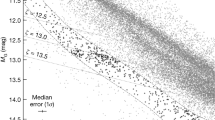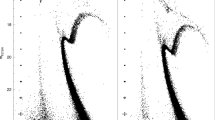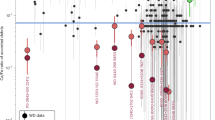Abstract
White dwarfs are stellar embers depleted of nuclear energy sources that cool over billions of years1. These stars, which are supported by electron degeneracy pressure, reach densities of 107 grams per cubic centimetre in their cores2. It has been predicted that a first-order phase transition occurs during white-dwarf cooling, leading to the crystallization of the non-degenerate carbon and oxygen ions in the core, which releases a considerable amount of latent heat and delays the cooling process by about one billion years3. However, no direct observational evidence of this effect has been reported so far. Here we report the presence of a pile-up in the cooling sequence of evolving white dwarfs within 100 parsecs of the Sun, determined using photometry and parallax data from the Gaia satellite4. Using modelling, we infer that this pile-up arises from the release of latent heat as the cores of the white dwarfs crystallize. In addition to the release of latent heat, we find strong evidence that cooling is further slowed by the liberation of gravitational energy from element sedimentation in the crystallizing cores5,6,7. Our results describe the energy released by crystallization in strongly coupled Coulomb plasmas8,9, and the measured cooling delays could help to improve the accuracy of methods used to determine the age of stellar populations from white dwarfs10.
This is a preview of subscription content, access via your institution
Access options
Access Nature and 54 other Nature Portfolio journals
Get Nature+, our best-value online-access subscription
$29.99 / 30 days
cancel any time
Subscribe to this journal
Receive 51 print issues and online access
$199.00 per year
only $3.90 per issue
Buy this article
- Purchase on Springer Link
- Instant access to full article PDF
Prices may be subject to local taxes which are calculated during checkout




Similar content being viewed by others
Data availability
The Gaia DR2 catalogue of white dwarfs used in this study is available from the University of Warwick astronomy catalogues repository, https://warwick.ac.uk/fac/sci/physics/research/astro/research/catalogues/gaia_dr2_white_dwarf_candidates_v2.csv. All modelling was performed with our extensive white-dwarf evolution code. We have opted not to make this multi-purpose code available, but the cooling sequences calculated for this work are available on request.
References
Mestel, L. On the theory of white dwarf stars. I. The energy sources of white dwarfs. Mon. Not. R. Astron. Soc. 112, 583–597 (1952).
Tassoul, M., Fontaine, G. & Winget, D. E. Evolutionary models for pulsation studies of white dwarfs. Astrophys. J. Suppl. Ser. 72, 335–386 (1990).
van Horn, H. M. Crystallization of white dwarfs. Astrophys. J. 151, 227–238 (1968).
Gaia Collaboration. Gaia Data Release 2. Summary of the contents and survey properties. Astron. Astrophys. 616, A1 (2018).
Garcia-Berro, E., Hernanz, M., Mochkovitch, R. & Isern, J. Theoretical white-dwarf luminosity functions for two phase diagrams of the carbon-oxygen dense plasma. Astron. Astrophys. 193, 141–147 (1988).
Segretain, L. et al. Cooling theory of crystallized white dwarfs. Astrophys. J. 434, 641–651 (1994).
Althaus, L. G., García-Berro, E., Isern, J., Córsico, A. H. & Miller Bertolami, M. M. New phase diagrams for dense carbon-oxygen mixtures and white dwarf evolution. Astron. Astrophys. 537, A33 (2012).
Horowitz, C. J., Schneider, A. S. & Berry, D. K. Crystallization of carbon–oxygen mixtures in white dwarf stars. Phys. Rev. Lett. 104, 231101 (2010).
Hughto, J. et al. Direct molecular dynamics simulation of liquid-solid phase equilibria for a three-component plasma. Phys. Rev. E 86, 066413 (2012).
Winget, D. E., et al. An independent method for determining the age of the universe. Astrophys. J. 315, 77–81 (1987).
Fontaine, G., Brassard, P. & Bergerson, P. The potential of white dwarf cosmochronology. Publ. Astron. Soc. Pacif. 113, 409–435 (2001).
Obertas, A. et al. The onset of convective coupling and freezing in the white dwarfs of 47 Tucanae. Mon. Not. R. Astron. Soc. 474, 677–682 (2018).
García-Berro, E. et al. A white dwarf cooling age of 8 Gyr for NGC 6791 from physical separation processes. Nature 465, 194–196 (2010).
Bédard, A., Bergeron, P. & Fontaine, G. Measurements of physical parameters of white dwarfs: a test of the mass-radius relation. Astrophys. J. 848, 11 (2017).
Gaia Collaboration. Gaia Data Release 2: observational Hertzsprung–Russell diagrams. Astron. Astrophys. 616, A10 (2018).
Hansen, B. M. S. et al. The white dwarf cooling sequence of the globular cluster Messier 4. Astrophys. J. 574, L155–L158 (2002).
Tremblay, P.-E., Kalirai, J. S., Soderblom, D. R., Cignoni, M. & Cummings, J. White dwarf cosmochronology in the solar neighborhood. Astrophys. J. 791, 92 (2014).
Gentile Fusillo, N. P. et al. A Gaia Data Release 2 catalogue of white dwarfs and a comparison with SDSS. Mon. Not. R. Astron. Soc. 482, 4570–4591 (2019).
Tremblay, P.-E., Ludwig, H.-G., Steffen, M. & Freytag, B. Spectroscopic analysis of DA white dwarfs with 3D model atmospheres. Astron. Astrophys. 559, A104 (2013).
El-Badry, K., Rix, H.-W. & Weisz, D. R. An empirical measurement of the initial–final mass relation with Gaia white dwarfs. Astrophys. J. 860, L17 (2018).
Chandrasekhar, S. The highly collapsed configurations of a stellar mass. (Second paper.) Mon. Not. R. Astron. Soc. 95, 207–225 (1935).
Kleinman, S. J. et al. SDSS DR7 white dwarf catalog. Astrophys. J. Suppl. Ser. 204, 5 (2013).
Bergeron, P., Saffer, R. A. & Liebert, J. A spectroscopic determination of the mass distribution of DA white dwarfs. Astrophys. J. 394, 228–247 (1992).
Kalirai, J. S., Richer, H. B., Hansen, B. M. S., Reitzel, D. & Rich, R. M. The dearth of massive, helium-rich white dwarfs in young open star clusters. Astrophys. J. 618, L129–L132 (2005).
Tremblay, P.-E. et al. On the evolution of magnetic white dwarfs. Astrophys. J. 812, 19 (2015).
Kalirai, J. S. et al. Ultra-deep Hubble Space Telescope imaging of the small Magellanic cloud: the initial mass function of stars with M ≲ 1M ⊙. Astrophys. J. 763, 110 (2013).
Bertelli, G., Nasi, E., Girardi, L. & Marigo, P. Scaled solar tracks and isochrones in a large region of the Z–Y plane. II. From 2.5 to 20 M ⊙ stars. Astron. Astrophys. 508, 355–369 (2009).
Potekhin, A. Y. & Chabrier, G. Equation of state of fully ionized electron–ion plasmas. II. Extension to relativistic densities and to the solid phase. Phys. Rev. E 62, 8554–8563 (2000).
Marigo, P. Chemical yields from low- and intermediate-mass stars: model predictions and basic observational constraints. Astron. Astrophys. 370, 194–217 (2001).
Mestel, L. & Ruderman, M. A. The energy content of a white dwarf and its rate of cooling. Mon. Not. R. Astron. Soc. 136, 27–38 (1967).
Acknowledgements
This research received funding from the European Research Council under the European Union’s Horizon 2020 research and innovation programme number 677706 (WD3D) and under the European Union’s Seventh Framework Programme (FP/2007- 2013)/ERC Grant Agreement number 320964 (WDTracer). This work made use of data from the European Space Agency (ESA) mission Gaia (https://www.cosmos.esa.int/gaia), processed by the Gaia Data Processing and Analysis Consortium (DPAC, https://www.cosmos.esa.int/web/gaia/dpac/consortium). Funding for the DPAC was provided by national institutions, in particular the institutions participating in the Gaia Multilateral Agreement. Support for J.J.H. was provided by NASA through Hubble Fellowship grant #HST-HF2-51357.001-A, awarded by the Space Telescope Science Institute, which is operated by the Association of Universities for Research in Astronomy, Inc., under NASA contract NAS5-26555.
Author information
Authors and Affiliations
Contributions
P.-E.T. and B.H.D. identified and characterized the empirical crystallization sequence. G.F. made the evolutionary white-dwarf models used in this work. N.P.G.F., M.A.H. and T.C. constructed the Gaia white-dwarf sample employed in this study and performed the cross-match with other photometric and spectroscopic surveys. P.-E.T., B.T.G., T.R.M., J.J.H. and G.F. wrote the text and developed the argument for a crystallization sequence. E.C. and T.C. characterized the accuracy of Gaia measurements and derived parameters for white dwarfs.
Corresponding author
Ethics declarations
Competing interests
The authors declare no competing interests.
Additional information
Publisher’s note: Springer Nature remains neutral with regard to jurisdictional claims in published maps and institutional affiliations.
Rights and permissions
About this article
Cite this article
Tremblay, PE., Fontaine, G., Fusillo, N.P.G. et al. Core crystallization and pile-up in the cooling sequence of evolving white dwarfs. Nature 565, 202–205 (2019). https://doi.org/10.1038/s41586-018-0791-x
Received:
Accepted:
Published:
Issue Date:
DOI: https://doi.org/10.1038/s41586-018-0791-x
This article is cited by
-
Buoyant crystals halt the cooling of white dwarf stars
Nature (2024)
-
Thermodynamics of diamond formation from hydrocarbon mixtures in planets
Nature Communications (2023)
-
Probing atomic physics at ultrahigh pressure using laser-driven implosions
Nature Communications (2022)
-
Interspecies radiative transition in warm and superdense plasma mixtures
Nature Communications (2020)
-
An ultra-massive white dwarf with a mixed hydrogen–carbon atmosphere as a likely merger remnant
Nature Astronomy (2020)
Comments
By submitting a comment you agree to abide by our Terms and Community Guidelines. If you find something abusive or that does not comply with our terms or guidelines please flag it as inappropriate.



